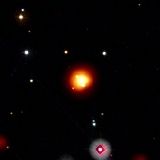
GRB 080913
Encyclopedia
GRB 080913 was a gamma-ray burst (GRB) observed on September 13, 2008. The Swift Gamma-Ray Burst
satellite made the detection, with follow-up and additional observations from ground-based observatories and instruments, including the Gamma-Ray Burst Optical/Near-Infrared Detector
(GROND) and the Very Large Telescope
. At 12.8 Gly and redshift of 6.7, the burst was previously the most distant GRB observed until the observation of GRB 090423
on April 23, 2009. This stellar explosion occurred around 825 million years after the Big Bang
.
Swift Gamma-Ray Burst Mission
The Swift Gamma-Ray Burst Mission consists of a robotic spacecraft called Swift, which was launched into orbit on 20 November 2004, 17:16:00 UTC on a Delta II 7320-10C expendable launch vehicle. Swift is managed by the NASA Goddard Space Flight Center, and was developed by an international...
satellite made the detection, with follow-up and additional observations from ground-based observatories and instruments, including the Gamma-Ray Burst Optical/Near-Infrared Detector
Gamma-Ray Burst Optical/Near-Infrared Detector
The Gamma-Ray Burst Optical/Near-Infrared Detector is an imaging instrument used to investigate Gamma-Ray Burst afterglows. It is operated at the MPI/ESO 2.2m telescope at the La Silla Observatory.- Discoveries :...
(GROND) and the Very Large Telescope
Very Large Telescope
The Very Large Telescope is a telescope operated by the European Southern Observatory on Cerro Paranal in the Atacama Desert of northern Chile. The VLT consists of four individual telescopes, each with a primary mirror 8.2m across, which are generally used separately but can be used together to...
. At 12.8 Gly and redshift of 6.7, the burst was previously the most distant GRB observed until the observation of GRB 090423
GRB 090423
GRB 090423 is a gamma-ray burst detected by the Swift Gamma-Ray Burst Mission on April 23, 2009 at 07:55:19 UTC. The afterglow of GRB 090423 was detected in the infrared, and allowed astronomers to determine that the redshift of GRB 090423 is z = 8.2, which makes GRB 090423 the second...
on April 23, 2009. This stellar explosion occurred around 825 million years after the Big Bang
Big Bang
The Big Bang theory is the prevailing cosmological model that explains the early development of the Universe. According to the Big Bang theory, the Universe was once in an extremely hot and dense state which expanded rapidly. This rapid expansion caused the young Universe to cool and resulted in...
.

